Eckhard Bick
PORTUGUESE SYNTAX
1. Introduction: Grammatical conventions
Within grammar, syntax deals with the linear structure of language, trying to explain how words (the minimal units of syntax) interact in forming a sentence (the maximal unit of syntax). In our approach, special attention will be paid to the form and function of syntactic units. Individual words as well as more complex structural parts of a sentence (groups and clauses) can all be described in terms of form and function.
Words and sentences
A simple definition of a word - especially useful for written language - states that words are alphanumeric strings delimited by blank spaces or punctuation in a text. This includes multi-word abbreviations like "PTB" or "DNA", and from a more pragmatic point of view (to be taken in this book), complex lexical units like "Estados Unidos", "em vez de", "anti-gás" may also qualify as "words".
With the same logic one can define a sentence as text delimited by a full stop, question mark or exclamation mark, or - syntactically - any functionally coherent chain of words, including one-word utterances like "venha!" and verbless statements like "ai, pobre de mim!".
Form and function
Different grammatical approaches describe sentences in different ways, focussing on different aspects of syntactic form and function.
Morphologically, form is the way in which words are composed and inflected - the basic unit being a morpheme - while morphological function deals with a given morphemes function within the word. The word comamos, for instance, can morphologically be analysed as the morpheme-string com(1)-a(2)-mos(3), where (1) is the word's lemmatic root, (2) a subjunctive vowel marker, and (3) the 1.person plural ending, while tense is not explicited (present tense as zero morpheme). Words can be assigned morphological word classes according to which categories of inflection or derivation they allow. Thus, comemos is a verb, because it features mode (subjunctive), tense (present), person (1.) and number (plural).
Syntactically, form is the way in which a sentence is structured, i.e. how its words are chained, ordered and grouped. Syntactic function, then, is how words or groups of words function in relation to each other or to the sentence as a whole. Words can be assigned syntactic word classes according to which categories of syntactic form or function they allow. Prepositions, for example, are usually defined not morphologically, but by syntactic form, i.e. as "headers" for noun groups or infinitives.
Syntactic models
Three basic types of syntactic models will be discussed in the following, on the one hand the classical functional model, on the other hand the form based approaches of dependency and constituent grammar which in their pure form both leave function implicit. Next, we will discuss how different models can be integrated so as to cover both form and function, as is the case when function labels are added to a dependency or constituent diagram, or when dependency markers are attached to function labels as in the word based Constraint Grammar model.
The flat classical model: word function, no form
This is the system taught
in Danish primary schools, albeit with symbols ("kryds og bolle") instead
of letters. The system allows ordinary running text, and yields a simple
structure, which is psychologically easy to grasp, since function markers
are attached to the semantically "heavy" words in the sentence, rather
than to groups of words (it is hipopótamo that receives
the subject tag, not o meu hipopótamo.
O
meu
hipopótamo
não
come
peixe.
S
A
V
O
Pure Dependency Grammar:
word chains (syntactic form), no function
In Dependency Grammar every word is attached to another word, its head, of which it is a dependent. A word can have more than one dependent, but only one head. The finite verb roles as pivot of the sentence, being its uppermost node.
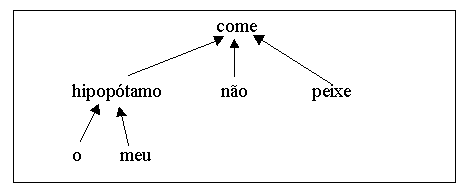
Dependency Grammar does not use word-less nodes or zero (empty) constituents, and its strictly word-based analysis has the pedagogical advantage of not having to "see" larger units before constituent relations can be established. Rather, constituents grow larger as the analysis progresses. Thus, it doesn't matter whether meu is attached to hipopótamo before or after hipopótamo is attached to come.
In dependency grammar, syntactic function is expressed indirectly as the asymmetrical relation between heads and dependents.
Pure Constituent Grammar:
Hierarchical word grouping (syntactic form), no function
(Acredito (que (o meu hipopótamo) não come peixe))
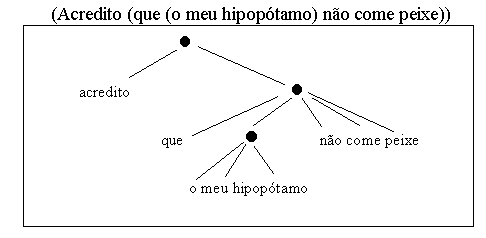
Conceptually, Constituent Grammar works "top-down", - a sentence is split into (maximal) constituents, and those constituents that are not words but groups of words, are marked by a "non-terminal" (i.e. word-less) node on that level (small circles in the illustration), and are further split into a new generation of (maximal) constituents, on the next lower level, - and so on, until terminal nodes (words) are reached throughout the whole tree.
Constituent Grammar can be expressed by rewriting rules, where a certain type of non-terminal node can be rewritten as a sequence of non-terminals and terminals (words or word classes). Noun phrases, for instance, could be rewritten as a chain of optional articles, pronouns and adjectives followed by a noun. With a complete set of rewriting rules a generative constituent grammar seeks to define all and only of such word sequences that form sentences in a given language.
In constituent grammar, syntactic function is expressed indirectly as the way in which constituents can be combined into larger constituents (in English, for instance, a subject would be that np [noun phrase] which is left when you strip a clause of its vp [verb phrase]).
Usually none of the models described here are used in teaching in pure form. Hybrid models, where models make use of each other's terminology, are not uncommon. Thus, Constituent Grammar can be made to handle dependency relations, and both Dependency Grammar and Constituent Grammar can easily be enriched by functional information from the classical model.
Adding function
1.4.1.
Dependency Grammar with function labels
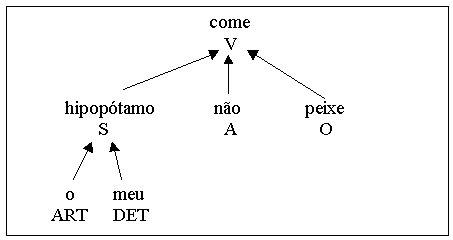
In the example, hipopótamo has not only been identified as head of o and meu and as dependent of come, but also as subject (S), while its dependents have been classified as article-modifier (ART) and determiner-modifier (DET), respectively.
1.4.2.
Constraint Grammar
Constraint Grammar uses a flat dependency notation in combination with function labels, thus integrating the classical system of word based function. Directed open dependency markers (> = head to the right, < = head to the left) are attached to individual words, and combined with function symbols:
1.4.3.
Enriched Constituent Grammar
Dependency grammar's different concept of syntactic form can be integrated into the constituent grammar notation, yielding a minimum of function:
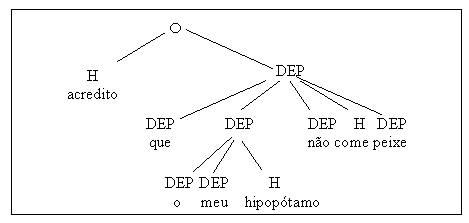
As can be seen, of the constituents at any given level (with the exception of the top node), there is now always one (and only one) "primus inter pares", the groups head (H), degrading its other constituents into dependents (DEP). In the same fashion, function can be added. The English VISL system, for instance, is a hybrid model where function has been introduced at the clause level:
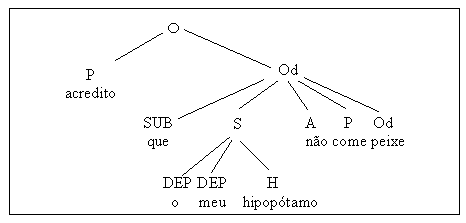
Also on the form side, both dependency and constituent models presented here can be enriched. Thus, apart from model-inherent information about syntactic form, one can, for instance, mark word nodes for (morphological) word class. Regarding non-terminal nodes in tree structures one can distinguish between groups and clauses, and subdivide these according to structure and typical head classes. A noun phrase (np) can thus both be defined (i) as a group with a noun as head, or (ii) as a group allowing articles, determiners or adjectives as inflecting modifiers.
Following VISL conventions, both form and function should be made explicit for every word or node (bracket), with function symbols in capitals and form symbols in small letters, the two being separated by a colon (horizontal notation) or an underline (vertical notation).
Using the Portuguese symbol set, we get, for the above example, the following tree:
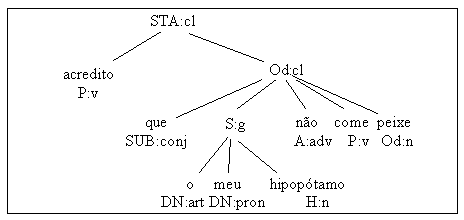
In Constraint Grammar's flat dependency notation, the same tree can be expressed as in-text information without bracketing, with group information subscripted at the group's head, and subclause information superscripted at the clause's first verb or complementizer:
AcreditoMV:v queSUB:conj<ACC:fcl o>N:art meu>N:det hipopótamoSUBJ>:n nãoADVL>:adv comeMV:v peixe.